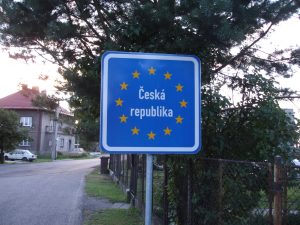64 Europe: Population Geography III – Polish Migration in the EU
This chapter was written by an expert on this particular topic – Peter Meserve.
The European Union (EU) was officially established in 1993 from the merger of the EEC, ECSC, and several other acronyms. By establishing standard laws allowing goods, services, and money to move easily across borders, the EU created more and more linkages among its members. Though news about Brexit (the United Kingdom (UK) leaving the EU) has dominated recent headlines, the EU still functions to unify much of Europe – particularly with regard to economics, although social, security, and political ties are also important.
The movement of people within the EU has also been freer, though this has been a more deliberate and complicated process. Migration changes the demographics and economics of both countries involved and therefore always involves nationalist political issues. Twenty-two of the EU’s twenty-seven members participate in the Schengen Area where border controls and passports are not required and consequently there is greater international mobility. See Chapter 53 for more on the Schengen Agreement. Poland is a member of this Area and is a good example of the complications of migration within the EU.
The international migration of Poles (intra-EU specifically) involves crossing boundaries and therefore needs the permission of both governments. Poland’s boundaries have changed tremendously over the centuries. In the mid-1500s, a Poland-Lithuania government controlled the lands from the Baltic Sea almost to the Crimean Peninsula in the Black Sea. Later, after invasions from surrounding countries, there was no ‘Poland’ on the map from 1795 to 1918. Following World War II (WWII), Poland’s modern boundaries were established and, equally important, Poles themselves were relocated (from countries to the east) into the new Poland while Germans were evicted from the western area. Now still, Poland borders Germany, Czechia, Slovakia, Ukraine, Belarus, Lithuania, and Russia.
During the Cold War years after WWII, Polish mobility was severely limited, as was the case in other countries behind (to the east of) the Iron Curtain. Relatively few Poles were able to migrate for economic or political reasons, many fewer reached western Europe. When Germany reunified in 1989 as the Berlin Wall came down, some immigrants were allowed to help in rebuilding the country and over the next decade Poles made up the majority of these seasonal and contract workers (technically temporary). National political issues in Germany (West Germany was a founding member of the EU) later caused this migration to drop dramatically.
 Poland joined the EU in 2004, ten years after applying. Nine other countries joined at the same time, including seven from East Europe, all with poorer economies than the EU average. Most of the existing members of the EU had concerns about allowing free mobility for Poland and the other new members lest it adversely affect their own employment and economies. Indeed, for years, a hypothetical “Polish plumber” was pushed by nationalists as a symbol of the loss of jobs to migrants.
Poland joined the EU in 2004, ten years after applying. Nine other countries joined at the same time, including seven from East Europe, all with poorer economies than the EU average. Most of the existing members of the EU had concerns about allowing free mobility for Poland and the other new members lest it adversely affect their own employment and economies. Indeed, for years, a hypothetical “Polish plumber” was pushed by nationalists as a symbol of the loss of jobs to migrants.
Only three members of the EU – Sweden, Ireland, and the UK – immediately allowed immigration to the new member countries, in large part because laborers were needed. Poles began to migrate in large numbers to Ireland but especially to the UK, since job conditions were very favorable. Not surprisingly, most of the Poles were male and in their twenties; surprisingly, many were well-educated yet accepted jobs in the construction and the hospitality sector. As a side effect, the number of students in Poland who studied English as a second language doubled. (Almost all Poles are bilingual or polylingual; English replaced Russian as a common second language, although German remains popular.)
Polish mobility to European countries has remained high for the most part after joining the EU; during the first decade of the 21st Century Eurostatistics listed Poles as the nationality of the most migrants within the EU. While the largest group of Poles was located in the UK (Germany was second), significant numbers were working in France, Ireland, and Italy. National surveys in Poland found that one out of eight adult Poles had worked abroad and that over two million Poles had lived outside the country in the ten years after joining the EU. While some Poles sought permanent residence in these countries, the vast majority returned to Poland.

Within Poland, workers leaving for elsewhere in the EU have both helped the finances of some regions but harmed the economic situations of others. Particularly in the earlier stages, more Poles emigrated from the southern and eastern border areas of the country, especially from Opole (bordering Czechia) and Podlaskie (bordering Belarus.) The loss of laborers was compensated by the increase in remittances that the Poles sent back home from their higher paychecks. Overall, in the five years following EU membership, the amount of remittances doubled (and also shifted from jobs in Germany to jobs in Ireland and the UK.)
National and international issues also affect Polish mobility. The 2007-8 recession both increased the number of Poles seeking positions elsewhere in the EU and at least temporarily decreased the amount of positions available. On the whole, Poles worked in job sectors that did not threaten the larger populations. However, as Brexit showed, in times of stress foreign workers (specifically Poles in the UK) are seen as enemies and occasionally attacked as such. International migration is a divisive political issue across the globe. The Schengen Agreement and Polish migration under that pact present interesting opportunities for geographic study.
Did You Know?
Cited and additional bibliography:
Charlemagne. 2020. “Poland Is Cocking up Migration in a Very European Way.” The Economist. February 22, 2020. https://www.economist.com/europe/2020/02/22/poland-is-cocking-up-migration-in-a-very-european-way.
insidious and subtle M. 2008. The Former Border. https://tinyurl.com/czechiapoland. Attribution-NonCommercial 2.0 Generic (CC BY-NC 2.0).


